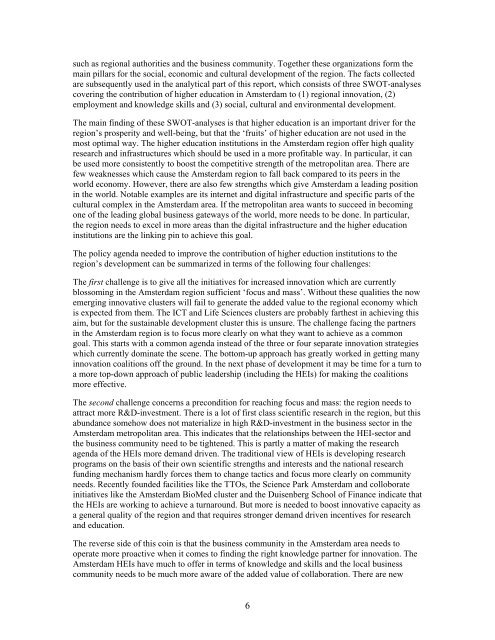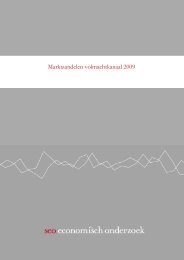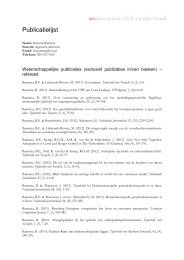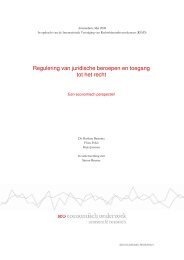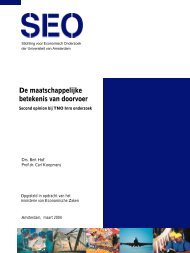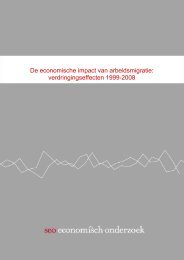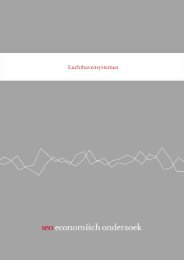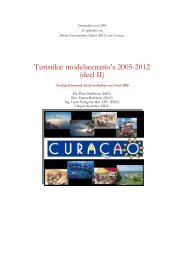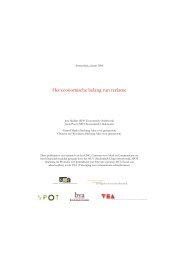Amsterdam, Netherlands - SEO Economisch Onderzoek
Amsterdam, Netherlands - SEO Economisch Onderzoek
Amsterdam, Netherlands - SEO Economisch Onderzoek
You also want an ePaper? Increase the reach of your titles
YUMPU automatically turns print PDFs into web optimized ePapers that Google loves.
such as regional authorities and the business community. Together these organizations form themain pillars for the social, economic and cultural development of the region. The facts collectedare subsequently used in the analytical part of this report, which consists of three SWOT-analysescovering the contribution of higher education in <strong>Amsterdam</strong> to (1) regional innovation, (2)employment and knowledge skills and (3) social, cultural and environmental development.The main finding of these SWOT-analyses is that higher education is an important driver for theregion’s prosperity and well-being, but that the ‘fruits’ of higher education are not used in themost optimal way. The higher education institutions in the <strong>Amsterdam</strong> region offer high qualityresearch and infrastructures which should be used in a more profitable way. In particular, it canbe used more consistently to boost the competitive strength of the metropolitan area. There arefew weaknesses which cause the <strong>Amsterdam</strong> region to fall back compared to its peers in theworld economy. However, there are also few strengths which give <strong>Amsterdam</strong> a leading positionin the world. Notable examples are its internet and digital infrastructure and specific parts of thecultural complex in the <strong>Amsterdam</strong> area. If the metropolitan area wants to succeed in becomingone of the leading global business gateways of the world, more needs to be done. In particular,the region needs to excel in more areas than the digital infrastructure and the higher educationinstitutions are the linking pin to achieve this goal.The policy agenda needed to improve the contribution of higher eduction institutions to theregion’s development can be summarized in terms of the following four challenges:The first challenge is to give all the initiatives for increased innovation which are currentlyblossoming in the <strong>Amsterdam</strong> region sufficient ‘focus and mass’. Without these qualities the nowemerging innovative clusters will fail to generate the added value to the regional economy whichis expected from them. The ICT and Life Sciences clusters are probably farthest in achieving thisaim, but for the sustainable development cluster this is unsure. The challenge facing the partnersin the <strong>Amsterdam</strong> region is to focus more clearly on what they want to achieve as a commongoal. This starts with a common agenda instead of the three or four separate innovation strategieswhich currently dominate the scene. The bottom-up approach has greatly worked in getting manyinnovation coalitions off the ground. In the next phase of development it may be time for a turn toa more top-down approach of public leadership (including the HEIs) for making the coalitionsmore effective.The second challenge concerns a precondition for reaching focus and mass: the region needs toattract more R&D-investment. There is a lot of first class scientific research in the region, but thisabundance somehow does not materialize in high R&D-investment in the business sector in the<strong>Amsterdam</strong> metropolitan area. This indicates that the relationships between the HEI-sector andthe business community need to be tightened. This is partly a matter of making the researchagenda of the HEIs more demand driven. The traditional view of HEIs is developing researchprograms on the basis of their own scientific strengths and interests and the national researchfunding mechanism hardly forces them to change tactics and focus more clearly on communityneeds. Recently founded facilities like the TTOs, the Science Park <strong>Amsterdam</strong> and colloborateinitiatives like the <strong>Amsterdam</strong> BioMed cluster and the Duisenberg School of Finance indicate thatthe HEIs are working to achieve a turnaround. But more is needed to boost innovative capacity asa general quality of the region and that requires stronger demand driven incentives for researchand education.The reverse side of this coin is that the business community in the <strong>Amsterdam</strong> area needs tooperate more proactive when it comes to finding the right knowledge partner for innovation. The<strong>Amsterdam</strong> HEIs have much to offer in terms of knowledge and skills and the local businesscommunity needs to be much more aware of the added value of collaboration. There are new6


